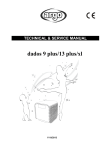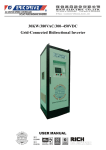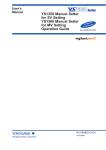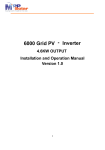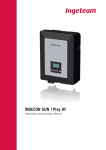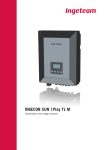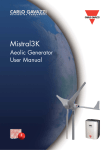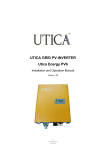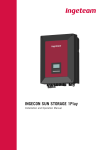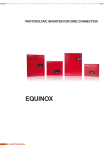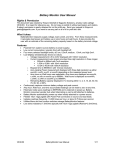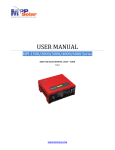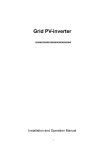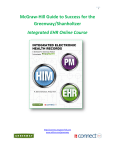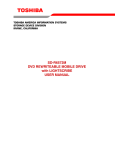Download User M User Manual
Transcript
User M User Manual Table of Contents 0 Table of Contents Safety of life .............................................................................................................. 2 Safety of installation ................................................................................................ 3 Safety of machinery ................................................................................................. 3 Chapter 1 Wind Power System ............................................................................ 5 1-1 Wind Turbine Specifications ............................................................................................ 5 1-2 Wind Turbine Description ................................................................................................ 7 1-3 Grid-tied Wind Power Inverter Specifications ................................................................. 8 1-4 Grid-tied Wind Power Inverter Description ..................................................................... 9 1-5 Wind Power System Operation ........................................................................................ 9 Chapter 2 Installation of Wind Power System ........................................................... 11 2-1 Installation of Wind Turbine ............................................................................................ 11 2-2 Installation of Grid-tied Wind Power Inverter.................................................................. 15 Chapter 3 Wind Power System Operation ................................................................... 25 3-1 Start Test ........................................................................................................................... 25 3-2 Instruction of Grid-tied Wind Power Inverter .................................................................. 25 Chapter 4 Protection ............................................................................................................ 27 4-1 Electromagnetic Brake Protection .................................................................................... 27 4-2 High Wind Protection (Furl Protection) ........................................................................... 27 Chapter 5 Troubleshooting ................................................................................................ 28 1 Please read this manual carefully and follow its instructions and recommendations, this manual will assist you to operate a renewable energy system safely and pleasantly. Safety of life 01. Never touch any switch with wet hands. 02. Always check and make sure there are no obstacles or people near the machine’s movable parts before operating the machine. 03. Cover your hair and do not wear loose clothing or jewelry to avoid becoming tangled or caught in the machine. 04. Never touch or stand near the moving parts of the machine while the machine is operating. Serious injury may occur by being caught between the moving parts. 05. Please avoid approaching the wind turbine. The high voltage of the turbine or inverter may cause casualty or electrical shock if touch, or you may get burnt due to electrical short circuit. 06. Always turn off the power before performing maintenance and inspection. Maintenance and inspection inside the cover is especially dangerous. 07. Do not climb on the machine unless absolutely necessary. 08. Machine and electricity of a renewable energy system contains certain danger, it may cause death or injury while misuse the machine. 09. Improper construction work may weaken the strength of tower or support frame structure, and result in casualty, death or losses of property. 10. Lack of maintenance in any part of the system, improper operation of the wind energy power system and loose of components or parts may cause casualty, death or losses of property. 11. Please avoiding approaching the blade due to high speed rotary blade due to the high possibility causing casualty or death, please shut off the system before performing maintenance. 12. Do not lean on the machine while the machine is operating. Leaning on the covers can be very dangerous. 13. If the turbine becomes loose or a loose sound is heard in tower, the system must be shut off immediately. A loose turbine or part will damage the turbine body soon enough, and it is possible to cause the tower to lean or to collapse and results in casualty or death. 14. An untrained personnel or a person without adequate safety equipment is highly restricted to climb the tower. It is highly restricted to climb the tower before the blade of wind turbine stop as well. 15. High voltage system (any contact point of the primary side of the system) indicates danger of shock and fatal harm. All the construction work and maintenance of high voltage system line must be performed and executed by professional personnel. 16. To avoid danger, construction work and wiring must be done by professional personnel. 2 Safety of installation 01. Leave space for maintenance. Install the machine so that the covers of the machine can be opened without interference. 02. Make sure that the ground strong enough to support the machine. 03. Only an authorized electrical technician should perform work with the power cable connections. 04. Make sure that all bolts are tightened securely. 05. Make sure that all related hoses is connected secure. 06. The machine should be operated by one, well-trained person only. Injury can occur if more than one person operates the machine. If more than one operator is absolutely necessary, all involved operators must cooperate and be able to communicate. 07. Never start machine operation without the safety devices in place. 08. Construction work of tower or supporting frame must be done by professional installation personnel, electrical wire must be qualified product and wiring work be done by professional and qualified personnel. Construction work, wiring products and electrical installation personnel must be in accordance with construction regulation standard. 09. Related permission certificates and engineering certificates are required for safe installation. Location of tower, tower and tower foundation must be professionally designed. Soil and wind field status must be put into consideration when selecting a location. Tower must keep far away from buildings, neighboring properties or electrical power lines. Do not attempt to climb the tower, only experienced personnel with adequate safety equipment is allowed to climb the tower. It is recommended that when installing tower, keep it away from buildings and electrical power lines for at least 100 meters (300 feet). 10. The construction and wiring process must be in accordance with electrical engineering regulations. 11. Never remove the covers unless absolutely necessary. 12. These equipments must have proper heat elimination function; air current jam may bring fire disaster. Safety of machinery 01. Never remove the covers unless absolutely necessary. 02. Never put any tools or instruments on the machine operation panel or on any machine part. 03. Be careful not to operate the wrong switch. Visually check the switches on the operation panel before operating them. 04. Never change the parameter setting without consulting your local representative. If changed inadvertently, some parameters will cancel interlock setting. 05. Wiring work for 200 VAC or higher voltage circuits must be performed only by an authorized electrical technician. 3 06. Do not open the door of the electrical cabinet or the operation panel unless absolutely necessary. Opening the door allows dust, foreign matter, and moisture to enter the enclosure and can cause machine malfunctions. 07. Carry out daily, monthly, and semi-annual inspection as specified in this operation manual. 08. Clean the machine so that any abnormalities can be found easily. 09. The output wiring of wind power system may cause a low voltage shock whenever the rotor is turning. Caution must be implemented at all times to avoid electrical shock. 10. Please do not install wind power system near cliffs or precipices or on sharp hills such that the wind does not travel horizontally through the rotor. 11. The weight distribution of the system is specially balanced. Any change of the system weight and balance, especially the tail, may cause malfunction of the Furl Protection Function. 12. Additional Electromagnetic Brake Protection is provided by the electronic system controller; please refer to the electronic system controller manual for more details. 4 Chapter 1 Wind Power System This system is the latest small wind power system designed to provide electricity which can be used on several different type applications, such as batteries charging, or stand alone remote electrical power supply system. Furthermore, with the additional Grid-tied Wind Power Inverter, the wind power system can also be connected to the power grid. 1-1 Wind Turbine Specifications The wind turbine consists of a 2.4 meter rotor system and a generator which is 35cm in diameter. The 58 kilogram wind turbine is rated at 3000 watts @ 13.5 m/s wind speed. The wind turbine features superior low start-up wind speed blade design which provides great performance, very high system efficiency, and low noise. The wind turbine also provides the optional mono-tower kit and guyed tubular tilt tower kit. For tower installation procedures, please refer to the Chapter 2-1. Wind Turbine Specifications Rotor diameter 2.5 m Total weight 58 kg Start-up wind Speed 2.5 m/s Furl Protection Start @ 13.5 m/s Cut-in wind Speed 2.8 m/s Cut-out wind Speed 13.5 m/s Rated wind Speed 13.5 m/s Rated output 3000W @ 13.5 m/s Survival Wind Speed 50 m/s Rotor RPM 145 - 780rpm Maximum Power 3kW Generator Output (three types) 3Phase AC 30V-240V Generator 3-phase permanent magnet generator of an 18 poles structure Each wind turbine has a MSN (Manufacture Serial Number) printed on the tower mount. In addition, all three blades also have their own BSN (Blade Serial Number) printed at the blade root. The MSN/BSN are also written on the delivery box. We recommend writing it here as well The wind turbine system MSN:____________________ Blade BSNs :1. ___________________2.____________________3. ___________________ Date of Installation : __________________ 5 Central Body Assembly Tail Fin Tail Boom Spinner Nacelle Generator Casing Tower Mount Adapter Figure 1 Blade Wind turbine assembly Blades Generator Nacelle and Tail Assembly Figure 2 Complete Assembly Wind turbine major Components 6 1-2 Wind Turbine Description The major components of the wind turbine are shown as Figure 2. A. Blades / Rotor System The rotor system consists of three glass/carbon fiber blades. The glass/carbon fiber blades are structurally strong because there are extra glass/carbon reinforcing fibers layers that hold the full length of the blade. The blades absorb the energy of the wind and convert them into rotational forces that drive the generator. The rotor system includes three blades because three blades will provide excellent balance between the cost and efficiency and can run much smoother than two blades rotor. ※Warning: The composites blades are very strong in tension, but they are susceptible to impact damage. They should be handled carefully to avoid any impact during installation. B. Generator The generator converts the rotational energy of the blade/rotor system into electricity. It is a 3-phase permanent magnet generator of an 18 pole structure. The generator is a completely new design for the wind power system and could produce power at low rotating speeds. The output of the generator is three-phase variable-frequency alternating current (AC), but it can be rectified to direct current or connected to power grid through a grid-tied device. C. Central Body Assembly The central body assembly consists of the blade hub, generator casing, and the nacelle. It is the main structural “backbone” of the rotor system, the generator, the yaw bearings, slip-ring assembly, the tail, and the tower mount. The yaw bearings allow the wind turbine to turn around the top of the tower in order to head the wind. The slip-ring assembly is the electrical connecter to connect the movable part of the wind turbine and the fixed tower wiring. The slip-rings and yaw bearings are located inside the tower mount. The tower mount attaches wind power system to the top of the tower through the tower mount adapter. D. Tail Assembly and High-Wind Protect (Furl Protect) Function The tail assembly, which includes the tail boom and tail fin, will keep the generator Assembly and rotor facing to wind at wind speeds less than about 13.5 m/s. At wind speeds reaching approximately 13.5 m/s, the High-Wind Protect function actives and turns the rotor partially away from the wind to prevent the rotor over-speed. That allows the turbine to continue to generate electrical power before it reaching the safety shutdown control point in high winds. When the wind speed slower, the High-Wind Protect function will inactive and turn the turbine back to the heading wind position. 7 1-3 Grid-tied Wind Power Inverter Specifications • DSP based fully digital control • Converter ability:3.0kW/220VAC,50/60Hz • High efficiency: 95% above. • Maximum Power Point Tracking function • Anti-Islanding • LCD displays generation data & status • High power conversion efficiency • Easy installation DSP Fully Digital-Controlled Grid-tied Wind Power Inverter Output power 3000W Input Nominal voltage 180VAC Working range 30~300 VAC MPPT range 50~250 VAC Max. input current 18A Output Operational voltage 220VAC /230VAC / 240VAC Maximum Output current 14A Operational frequency 50/60Hz auto select Power factor >0.99 @ Full-Load Current distortion <4% Maximum Efficiency >95% Anti-Islanding VDE-0126 CE EN50178, IEC62103 Environment Protection degree IP43 Operation temperature -20 to 40°C Humidity 0 to 95%, non-condensing Heat Dissipation Convection Mechanical L×W×H 520*360*175mm Weight 18kg 8 1-4 Grid-tied Wind Power Inverter Description This product is a wind energy utility grid-tied system. Single-phase grid-tied wind power inverter is different from traditional stand- alone type wind energy inverter; it does not need additional expensive and large space required energy storage battery, hence free from considerable battery maintenance expense. It efficiently converts power generated from wind turbine, high efficiently converts to AC power and feed into grid, having the direct benefit of power generation and energy saving. 1-5 Wind Power System Operation A. Normal Operation The generator of wind power system should begin to generate electricity when the wind speed reaches approximately 3 m/s. The rotor rotational speed will increase with higher wind speed. The generator output is proportional to the third power of wind speed. Please refer to Figure 3 for the relationship between power output and wind speed. Figure 3 Power Curve: Wind Speed vs. Power ※ Note The operational wind speeds and performance in the manual assume the condition of sea-level altitude, steady winds, and moderate temperatures. High altitude, hot temperatures, turbulence and gusting winds will usually bring the system performance lower than expectation. 9 B. High-Wind Protection (Furl Protection) In case of high wind speeds, the High-Wind Protection Function system will protect the wind turbine automatically. When furled, the rotor will turn away from the wind direction, the rotor speed will reduce, and the power output of the turbine will be significantly reduced. High-Wind Protection Function is an easy method to provide high wind speed protection. The High-Wind Protection Function is based on basic physical relationship between the aerodynamics, rotor, gravity, and the specially designed tail shape and weight balance of the wind power system. The High-Wind Protection Function is completely passive, so it is very reliable. But there is one situation in the field that we have found can disrupt the operation of High-Wind Protection Function. If the wind turbine is installed on a sharp hill or next to a cliff so that the wind can come up through the rotor on an incline (e.g., from below; as opposed to horizontally) this will affect furling and can produce higher peak outputs. We strongly recommend avoiding this situation. ※ Caution The weight distribution of the system is specially balanced. Any change of the system weight and balance, especially the tail, may cause malfunction of the High-Wind Protection Function. ※ Note Additional Electromagnetic Brake Protection Function is provided by the electronic system controller, please refer to Chapter 4 Protection. 10 Chapter 2 Installation of Wind Power System ※ Caution ¾ To avoid danger, construction work and wiring must be done by professional personnel. ¾ The construction and wiring process must be in accordance with electrical engineering regulations. ¾ Please read this manual carefully and follow its instructions and recommendations. 2-1 Installation of Wind Turbine ※ Parts and Accessories List: There are three shipping boxes for a complete set of wind turbine. Details are as follows, Box1 Central body and Accessories 68 cm x 48.5 cm x 35 cm (L x W x H) weight 40kg Box2 Blades 121 cm x 30 cm x 37 cm (L x W x H) weight 13.7 kg Box3 Tail assembly 152 cm x 48 cm x 4.5 cm (L x W x H) weight 6.2kg Before Installation, please check the packing for the following items: NO Description Specification Unit Qty. 1 Blade 1.2 m material:Glass + Carbon fiber pcs 2 Body Permanent magnet synchronous generator pcs 3 Spinner material:Nylon + Glass fiber pcs 1 4 Tail Fin Plug pcs 1 5 Tail Fin material:Zinc-coated steel pcs 1 6 Stainless Steel Screw 12 m/m * 63 m/m pcs 6 7 Stainless Steel Nut 12 m/m pcs 10 8 Stainless Steel Flat Washer 12m/m pcs 10 9 Stainless Steel Spring Washer 12m/m pcs 12 10 Stainless Steel Screw 8m/m * 75m/m pcs 2 11 Stainless Steel Nut 8m/m pcs 2 12 Stainless Steel Washer 8m/m pcs 4 13 Stainless Steel Screw 12m/m * 130m/m pcs 2 14 Stainless Steel Plate pcs 1 11 3 1 ※ Wind Turbine Assemble Procedure: (1) Fasten the three blades into the circular hub using two 12mm-diameter, 63mm-long bolts(6) for each blade. To refer Figure 4, firstly put one spring washer(9) through the bolt, follow by one flat washer(8), insert them through the blade, stainless steel plate(14) and hub, put another spring washer(9) through the protruding part of the bolt, apply Loctite to the thread, and fasten with a nut(7). Press the spinner into the hub. 3 6 8 7 9 14 Figure 4 9 Assembly of blades and spinner (2) Attach the tail assembly to the central body assembly using two 8mm-diameter bolts(10). To refer Figure 5, firstly put one flat washer(8) through the bolt(10), insert them through the tail and nacelle, put another flat washer(8) to the bolt, apply Loctite to the thread, and fasten with a nut(11). (3) Attach the wind turbine power output wires to the power cable with insulated heat shrunk tube and straighten the cable. Put the supporting pole into the tower mount adapter using two 12mm-diameter, 130mm-long bolts(13). To refer Figure 6, firstly put one flat washer(8) through the bolt(13), insert them through the adapter and pole, put another flat washer(8) to the bolt(13), apply Loctite to the thread, and fasten with two nuts(7).(Notice! Don’t PRESS or DISTORY wires when assemble supporting pole) 12 10 8 8 11 Figure 5 Assembly of tail and tail plug 7 8 8 13 Figure 6 Assembly of wind turbine and supporting pole (4) Hoist the wind turbine and supporting pole into position, fasten the pre-installed foundation bolts with nuts and apply Loctite to the thread to complete the installation. 13 ※Support Tower Suggestion: 6-meter guyed tower 9-meter guyed tower Wind turbine 1.2 m 1.2 m 3” Steel Pipe 34mm 73mm Steel pipe 1.8 m 12.8mm 4.8 m 3” Steel Pipe 6m 3 ~4.8m 3.5” Steel Pipe Steel Cable: Min. Dia.: 6mm 3 inch Steel Tube: ÆOuter Dia.: 89.5mm ÆWall Thickness: 4.5mm 3.5 inch Steel Tube: ÆOuter Dia.:102.1mm ÆWall Thickness: 4.5mm Cylindrical Foundation: 90 cm in diameter, 100 cm in depth, steel reinforced concrete 4.5~7.8m Anti-vibration 12 mm Bolt Hot Dip Galvanizing steel Diameter: 12mm >30mm 45o~60o 1.0 m 0.3 m Concrete Block Dimension: 0.8x0.8x0.3m 120cm 0.8 m 25cm 14 rubber insert 10cm 2-2 Installation of Grid-tied Wind Power Inverter ※Installation Procedure of Inverter: Conditions Do not operate the Inverter in an environment where the ambient temperature is outside the limits given in the specifications of this manual. These inverter units are in-tended for use in a temperature-controlled, indoor area free of conductive contaminants. Select a location that will provide good air circulation for inverter at all times. ◇ Placement Mounting the Grid-tied Inverter on the wall (1) (2) (3) (4) (5) (6) (7) (8) (9) The mounting background must be firm. The ambient temperature must be between -20°C and +40°C. Install at a shading roof, do not expose the inverter to direct sunlight. Keep it in good ventilated situation; a minimum distance of 10 inch (254 mm) must be clear around the inverter. The heat sink can reach a temperature of more than +80°C. The air circulation must be sufficient for heat dissipation. Provide a correct position of the inverter for mounting. The inverter is mounted on the back side with the metal strap.(as Figure 7) Check mounting is firm. Please ensure to install the grid-tied wind power inverter in a ventilated location. There should be no any stack around one meter of its surrounding. 15 STEP 1:Heat dissipation STEP 2:Fix the metal strap Keep a minimum distance of 8-12 inch clear Fixed six screws around the inverter STEP 3:Hang up STEP 4:Check it firm Wall Wall 16 Fixed position Fixed position Fixed position [mm] Figure 7 Metal strap of Inverter ※ AWG to Metric Wire Size Conversion Chart AWG gauge Diameter (mm) AWG gauge Diameter (mm) 0000 (4/0) 11.68 mm 4 5.19 mm 000 (3/0) 10.40 mm 6 4.11 mm 00 (2/0) 9.27 mm 8 3.26 mm (1/0) 8.25 mm 10 2.59 mm 1 7.34 mm 12 2.05 mm 2 6.54 mm 14 1.63 mm 3 5.83 mm 16 1.29 mm 17 ※ Wind Power System Wiring Description Power Wire Size Selection Please connect electrical wire according to each contact marked with description. Regulated wire size as follows:(Detailed wiring diagram as Figure 8,Figure 9) AC output wire use a size at least 12AWG(or 3.5 mm2) black copper wire. Wind turbine wires use at least 12AWG(or 3.5 mm2) and above copper wire, these wires to be of different color in order to distinguish R, S, T 3-phase power. It is recommended to use 12 AWG(or 3.5 mm2) and above yellow/green copper wire on machine housing earthing(grounding) wire. Notice of Wiring ¾ Before wiring, please finish installation of the wind power inverter, meanwhile, check and ensure that there is no fuse breaker of main distribution board is in close status. ¾ In order to ensure quality of electrical wiring. Please use a wire size recommended in this manual and in accordance with wiring standard of electrical regulations. ¾ The GREEN wire of wind turbine is neutral wiring output from generator, it’s for special application. Please leave GREEN wire isolated, don’t wire it to any conductive goods. 18 Figure 8 wiring diagram of brake control cabinet 19 Component List of Brake Control Cabinet NO Label Description Specification Qty. 1 BOX Electrical brake control cabinet 470mm x 320mm 1 2 NFB1 No fuse breaker 20A/2P/300VAC 1 3 NFB2,NFB3 No fuse breaker 50A/3P/600VAC 2 4 RY1~RY6 Electromagnetic Brake main relay 35A(above)/220VAC(main contact) drive voltage 220V 6 5 RY7,RY8 Electromagnetic Brake aux. relay 5A(above)/220VAC(main contact) drive voltage 12Vdc 2 6 TB Terminal block 12x2P 600V/main contact 30A (above) 1 7 WH Wattmeter 220V/10(30)A/(50/60HZ) 1 8 C1,C2 AC capacitance X capacitor/0.22uF/275VAC 2 9 R1~R3 Power resistor 3Ω/1KW 3 10 PS DC power supply Input 200V~260V/Output 12Vdc; 1A (above) 1 Installation Procedure of Electrical Wire Brake control cabinet (1) When wiring, it is not necessary to open top cover of wind power inverter, ensure wiring is fixed (2) (3) (4) (5) (6) (7) (8) well and there is no danger of coming loose. As shown on Figure 8, there are nine wires from wind power inverter, they are R,S,T,L,N(12AWG), and al, a2(12AWG) short brake signal contact and b1,b2(12AWG) resistor brake contact. Wind turbine output R,S,T wire is connected respectively to manual brake switch, automatic brake switch and three relays’ C contact then finally connected to wind power inverter.(The GREEN wire of wind turbine is neutral wiring output from generator, it’s for special application. Please leave GREEN wire isolated, don’t wire it to any conductive goods.) The terminal block (European type) as attachment is connected respectively to a1, a2, b1, b2 contact. a1 and a2 connected to signal of automatic short circuit brake switch, b1 and b2 connected to signal of automatic resistor brake switch. AC output is a spiral exclusive socket connected to domestic utility distribution board, then connected to utility through bi-directional wattmeter. Grounding wire (PE) connected to wind power inverter and system grounding, please avoid connecting grounding wire with main line and ensure grounding is properly done. When adopting the third kind grounding, grounding resistor must be less than 10Ω. (9) Brake Resistor consists of three 3Ω/1KW; Y connection is connected to three relay b contact 20 respectively. (10) Caution!When resistor brake occurs, it will cause heat. Installation location must be in a ventilated place. (11) Suggest L, N go through 1:1 isolation transformer to utility 220V/(50Hz or 60Hz). ※ Recommended specifications (1) Automatic short circuit brake switch:Consists of three relays, each relay stands 30A and above, coil start voltage 220V. (2) Automatic resistor brake switch:Consists of three relays, each relay stands 30A and above, coil start voltage 220V. (3) Resistor box:Consists of three 3Ω/1KW for Y connection. (4) Lightning device:Capacity of lightning device is related to distance of wind turbine and power distribution board INVERTER, please refer to electrical engineering regulations. 21 Figure 9 Brake Control Cabinet Placement 22 ※ Wiring Description of Inverter Loose six screws under the Inverter (as the red circle), after open it, there are two terminal block and node label. L and N are connected to utility AC power. R,S,T are connected to Wind turbine AC output. PE is grounding wire. The wire connected to L is recommended to use 12 AWG and above. Suggest using brown color. The wire connected to N is recommended to use 12 AWG and above. Suggest using blue color. The wire connected to R is recommended to use 12 AWG and above. Suggest using red color. The wire connected to S is recommended to use 12 AWG and above. Suggest using white color. The wire connected to T is recommended to use 12 AWG and above. Suggest using black color. The wire connected to PE is recommended to use 12 AWG and above. Suggest using green color. Wiring show as below figure: brown brown blue blue green green red gray red black black gray 23 The brown and blue wires gone through left spiral exclusive socket, connected tightly to L, N terminal respectively. The green wires gone through medium spiral exclusive socket, connected tightly to PE terminal. The red, white and black wires gone through right spiral exclusive socket, connected tightly to R, S and T terminal. Then lock six screws. Show as below figure: gray brown brow blue green red black blue green red black gray 24 Chapter 3 Wind Power System Operation 3-1 Start Test (1) Ensure input voltage is within rated range by measuring NFB1 with power meter. (2) Turn on NFB1 of Brake control cabinet, ensure utility voltage and frequency is within normal range. (3) Confirm the manual brake switch (NFB2, NFB3) turned to OFF. (4) Wind power inverter goes to switch-on screen, it will take a few minutes for the machine to do self-test and confirmation of utility voltage and frequency. (5) After output rated working range is confirmed, the wind turbine system will start to feed power to the utility. Then, the system operates automatically. 3-2 Instruction of Grid-tied Wind Power Inverter [ON/OFF] [UP] [DOW] Start / Close wind power inverter Switch [ON/OFF] to start/close wind power inverter. If [ON/OFF] is not pressed down, wind power inverter will automatically detect system, if the system works normally for 3 minutes, it will start to work automatically Start wind power inverter Press down [ON/OFF] for 3 seconds, buzzer sounds a long “beep” tone, the inverter has been started. If the whole system of utility and wind turbine is under normal condition, LCD will display「Waiting…」. If wind turbine produce energy to wind power inverter, inverter will begin conversion suitable energy to utility and wind turbine system operation normally. If wind energy is not enough, there is no energy output, and LCD will display「Low wind」. Close wind power inverter Press down [ON/OFF] for 2 seconds, buzzer sounds two short “beep” tone, wind power inverter will stay in standby, if [ON/OFF] is not pressed down again or power not re-started, the inverter will stay in standby. Default of wind power inverter will lock button key, if you need to look up internal parameter, [UP] and [DOWN] key must be pressed at the same time, buzzer will then sound two short “beep” tones, the locking of button key has been released. 25 [UP] Shift-up key Shift-up key[UP] indicates cyclical moving upwards, display respectively: Input power (Pi) Æ Input voltage/current (Vw/Iw) Æ Output power (Po) Æ Output voltage/current (Vs/Is) [DOWN] Shift-down key Shift-down key[DOWN] indicates cyclical moving downwards, display respectively: Input power (Pi) Å Output voltage/current (Vs/Is) Å Output power (Po) Å Input voltage/current (Vw/Iw) LCD Display List LCD display Discription (Brand Name) Display brand name. (Model Number) Vx.xx Display model number and Vx.xx:firmware version. Waiting… The status of wind turbine system is normally, waiting for wind energy feed-in, about 30sec. LOW_WIND When wind speed below 2.8m/sec, wind energy isn’t enough to feed-in grid. The wind power inverter no power output. record_No=xx To show system fault record recently. When system is malfunction, there’ll show corresponding fault record. If system power is off, the fault record will reset. Vs=xxxV Is=xx.xA Po=xxxxW Vw=xxxV Iw=xx.xA Pi=xxxxW Vs=xxxV:grid-tied voltage value(V). Is= xx.xA:grid-tied current value(A). Wind power inverter output power into grid(W). Vw=xxxV:Wind power inverter internal DC bus voltage value(V). Iw= xx.xA:Wind power inverter internal DC bus current value(A). The wind power output from wind turbine, and feed-in wind power inverter (W). 26 Chapter 4 Protection 4-1 Electromagnetic Brake Protection This wind turbine system has two kind of electromagnetic brake protection function:Resistor and Short-circuit Brake Protection. Using wind power inverter and brake control cabinet to perform this protection function. (1) Resistor Brake Protection: When wind speed exceeds 13.5m/s, system will start resistor brake protection function. Then wind turbine will slow down and system will disable resistor brake protection function and wind turbine will operate normally. (2) Short Circuit Brake Protection: When wind speed often exceeds 13.5m/s in a few minutes, system will start resistor brake protection for 30 seconds and short circuit brake actives for 5 minutes. 4-2 High Wind Protection (Furl Protection) The tail assembly, which includes the tail boom and tail fin, will keep the generator Assembly and rotor facing to wind at wind speeds less than about 13.5 m/s. At wind speeds reaching approximately 13.5 m/s, the High Wind Protect (Furl Protect) function actives and turns the rotor partially away from the wind to prevent the rotor over-speed. That allows the turbine to continue to generate electrical power before it reaching the safety shutdown control point in high winds. When the wind speed slower, the High-Wind Protect function will inactive and turn the turbine back to the heading wind position. 27 Chapter 5 Troubleshooting This chapter description fault code of wind power inverter and inspection method. Code Display Message Cause 2 UTILITY FAULT Utility power abnormal 3 DC VOLTS FAULT Input Voltage is too high 9 Current error Output current abnormal 10 OVER Temp Over temperature protection 12 Line freq error Grid frequency abnormal 13 OVER WG ERROR WT over speed 14 OVER Pout Over Load 15 DC V FAULT Surge Voltage to high 16 Braking…R Braking by resistor 17 Braking…S Braking by short circuit 23 GRID Vrms error Utility voltage too high 26 GRID Idc error DC offset current to grid>1A 28 Inspection z Check the connection between Inverter and utility. z Check utility voltage status. z Wind speed too high cause over voltage. z Check utility frequency and voltage status. z Was heatsink blocked or not? z Did the Inverter placed at ventilation position? z Check the connection between Inverter and utility. z Check utility frequency status. z Wind speed too high cause over voltage. z Inverter tripped, it’ll automatic reset in a while. z Was wind speed too high cause over voltage? The DC capacitor maybe burn out already. z When wind speed exceeds 13.5m/s, system will start resistor brake protection function. Then wind turbine will slow down and system will disable resistor brake protection function and wind turbine will operate normally. z When wind speed often exceeds 13.5m/s in a few minutes, system will start resistor brake protection for 30 seconds and short circuit brake actives for 5 minutes. z Was utility voltage over 10% normal voltage in a short time? z Check the connection between Inverter and utility. Was there connected other load? 30 Leakage Current 41 UTILITY DET F z Were electrical wires broken somewhere? Input device leakage current too z Does the impedance too low high between inverter case and wind generator coil? z Check the connection between Frequency over range Inverter and utility. z Check utility frequency status. 29 Distributor TECO Electric & Machinery Co., Ltd. 10F, NO.3-1, Yuan Cyu St., Nan-Kang District, Taipei 115, Taiwan TEL: 886-2-6615-9111 FAX: 886-2-6615-1033 http://www.teco.com.tw MU-0901E.02 The manual may be modified when necessary because of improvement of the product, modification, or changes in specifications. This manual is subject to change without notice.































